4.1.3: Angle-Angle-Side Triangles
- Page ID
- 4156
Law of sines: proportion based on ratios of sides and sines of the opposite angles.
You and a friend decide to go fly kites on a breezy Saturday afternoon. While sitting down to make your kites, you are working on make the best shape possible to catch the breeze. While your friend decides to go with a diamond shaped kite, you try out making a triangle shaped one. While trying to glue the kite together, you make the first and second piece lock together with a \(70^{\circ} \) angle. The angle between the first and third pieces is \(40^{\circ} \). Finally, you also have measured the length of the second piece and found that it is 22 inches long.
Your kite looks like this:
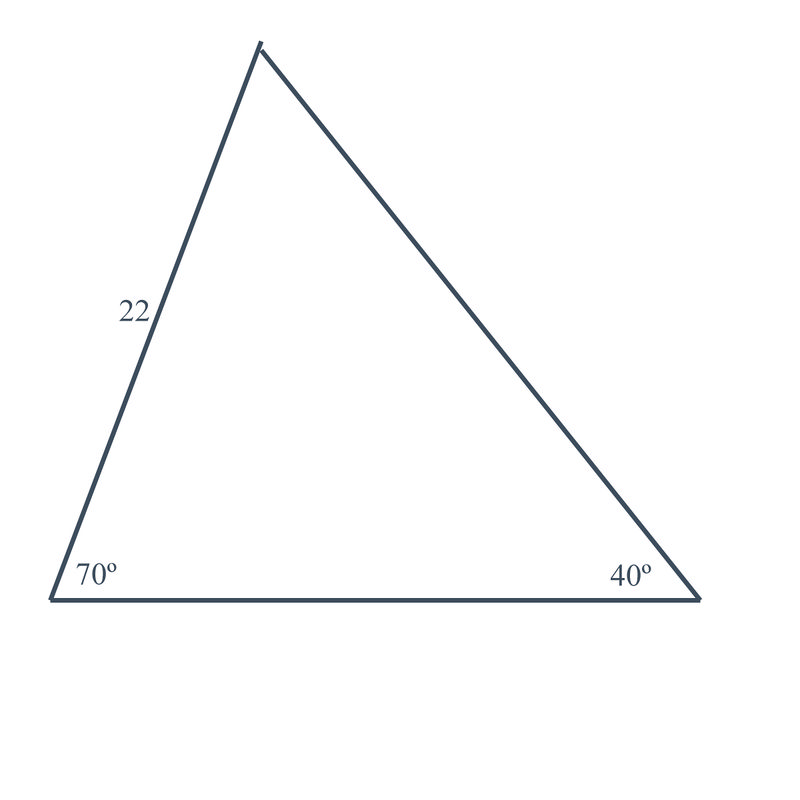
Is there a way to find out, using math, what the length of the third side will be?
AAS Triangles
The Law of sines states: \(\dfrac{\sin A}{a}=\dfrac{\sin B}{b}\). This is a ratio between the sine of an angle in a triangle and the length of the side opposite that angle to the sine of a different angle in that triangle and the length of the side opposing that second angle.
The Law of sines allows us to find many quantities of interest in triangles by comparing sides and interior angles as a ratio. One case where we can to use the Law of sines is when we know two of the angles in a triangle and a non-included side (AAS).
Using the Law of sines
1. using \(\Delta GMN\), \(\angle G=42^{\circ} \), \(\angle N=73^{\circ} \) and \(g=12\). Find \(n\).
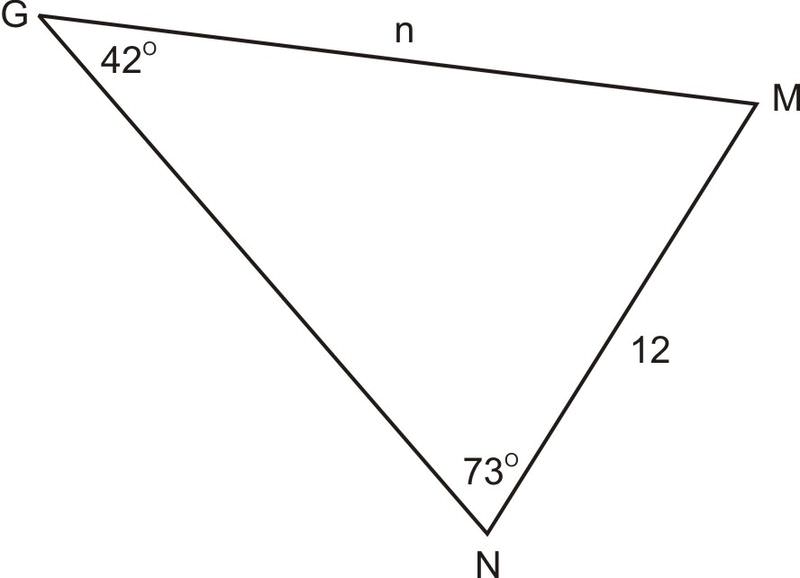
since we know two angles and one non-included side (\(g\)), we can find the other non-included side (\(n\)).
\(\begin{aligned} \dfrac{\sin 73^{\circ} }{n}&=\dfrac{\sin 42^{\circ} }{12} \\ n\sin 42^{\circ}&=12\sin 73^{\circ} \\ n&=\dfrac{12\sin 73^{\circ} }{\sin 42^{\circ} } \\ n&\approx 17.15 \end{aligned}\)
2. Continuing on from #1, find \(\angle M\) and \(m\).
\(\angle M\) is simply \(180^{\circ} −42^{\circ} −73^{\circ} =65^{\circ} \). To find side \(m\), you can now use either the Law of sines or Law of Cosines. Considering that the Law of sines is a bit simpler and new, let’s use it. It does not matter which side and opposite angle you use in the ratio with \(\angle M\) and \(m\).
Option 1: \(\angle G\) and \(g\)
\(\begin{aligned} \dfrac{\sin 65^{\circ} }{m}&=\dfrac{\sin 42^{\circ} }{12} \\ m\sin 42^{\circ}&=12\sin 65^{\circ} \\ m&=\dfrac{12\sin 65^{\circ} }{\sin 42^{\circ} } \\ m&\approx 16.25 \end{aligned}\)
Option 2: \(\angle N\) and \(n\)
\(\begin{aligned} \dfrac{\sin 65^{\circ} }{m}&=\dfrac{\sin 73^{\circ} }{17.15} \\ m\sin 73^{\circ}&=17.15\sin 65^{\circ} \\ m&=\dfrac{17.15\sin 65^{\circ} }{\sin 73^{\circ} } \\ m &\approx 16.25 \end{aligned}\)
3. A business group wants to build a golf course on a plot of land that was once a farm. The deed to the land is old and information about the land is incomplete. If \(AB\) is 5382 feet, \(BC\) is 3862 feet, \(\angle AEB\) is \(101^{\circ} \), \(\angle BDC\) is \(74^{\circ}\), \(\angle EAB\) is \(41^{\circ} \) and \(\angle DCB\) is \(32^{\circ} \), what are the lengths of the sides of each triangular piece of land? What is the total area of the land?
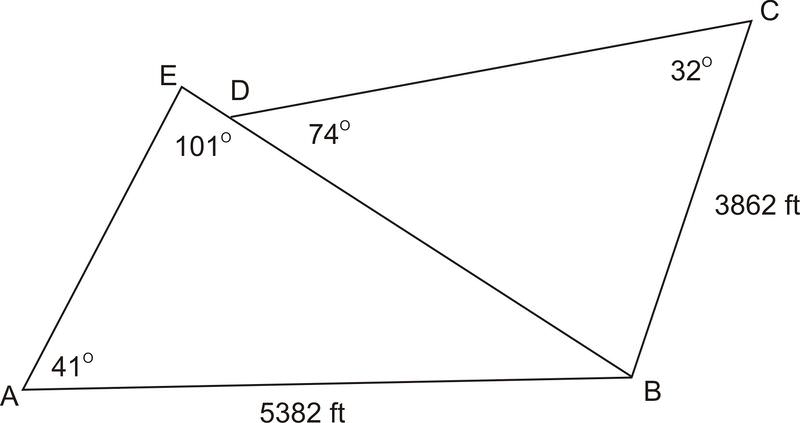
Before we can figure out the area of the land, we need to figure out the length of each side. In \(\Delta ABE\), we know two angles and a non-included side. This is the AAS case. First, we will find the third angle in \(\Delta ABE\) by using the Triangle Sum Theorem. Then, we can use the Law of sines to find both \(AE\) and \(EB\).
\(\begin{aligned}
\dfrac{\sin 101}{5382} &=\dfrac{\sin 38}{A E} & \dfrac{\sin 101}{5382}&=\dfrac{\sin 41}{E B} \\
A E(\sin 101) &=5382(\sin 38) & E B(\sin 101)&=5382(\sin 41) \\
A E &=\dfrac{5382(\sin 38)}{\sin 101} & E B&=\dfrac{5382(\sin 41)}{\sin 101} \\
A E &=3375.5 \text { feet } & E B &\approx 3597.0 \text { feet }
\end{aligned}\)
Next, we need to find the missing side lengths in \(\Delta DCB\). In this triangle, we again know two angles and a non-included side (AAS), which means we can use the Law of sines. First, let’s find \(\angle DBC=180−(74+32)=74^{\circ} \). since both \(\angle BDC\) and \(\angle DBC\) measure \(74^{\circ} \), \(\Delta DCB\) is an isosceles triangle. This means that since \(BC\) is 3862 feet, \(DC\) is also 3862 feet. All we have left to find now is \(DB\).
\(\begin{aligned} \dfrac{\sin 74}{3862}&=\dfrac{\sin 32 }{DB}\\ DB(\sin 74)&=3862(\sin 32) \\ DB&=\dfrac{3862(\sin 32)}{\sin 74} \\ DB &\approx 2129.0 \text{ feet} \end{aligned}\)
Finally, we need to calculate the area of each triangle and then add the two areas together to get the total area. From the last section, we learned two area formulas, \(K=\dfrac{1}{2} bc\sin A\) and Heron’s Formula. In this case, since we have enough information to use either formula, we will use \(K=\dfrac{1}{2} bc\sin A\) since it is less computationally intense.
First, we will find the area of \(\Delta ABE\).
\(\Delta ABE\):
\(\begin{aligned} K&=12(3375.5)(5382)\sin 41 \\ K&=5,959,292.8 \text{ ft}^2 \end{aligned}\)
\(\Delta DBC\):
\(\begin{aligned} K&=\dfrac{1}{2}(3862)(3862)\sin 32 \\ K&=3,951,884.6 \text{ ft}^2 \end{aligned}\)
The total area is \(5,959,292.8+3,951,884.6=9,911,177.4 \text{ ft}^2\).
Earlier, you were asked to find the length of the third side of the triangle.
Solution
since you know two angles and one non-included side of the kite, you can find the other non-included side using the Law of sines. Set up a ratio using the angles and side you know and the side you don't know.
\(\begin{aligned} \dfrac{\sin 70^{\circ} }{x}&=\dfrac{\sin 40^{\circ} }{22} \\ x&=\dfrac{22 \sin 70^{\circ} }{\sin 40^{\circ} } \\ x &\approx 32.146 \end{aligned}\)
The length of the dowel rod on the unknown side will be approximately 32 inches.
Find side "d" in the triangle below with the following information: \(e=214.9\), \(D=39.7^{\circ} \), \(E=41.3^{\circ}\)
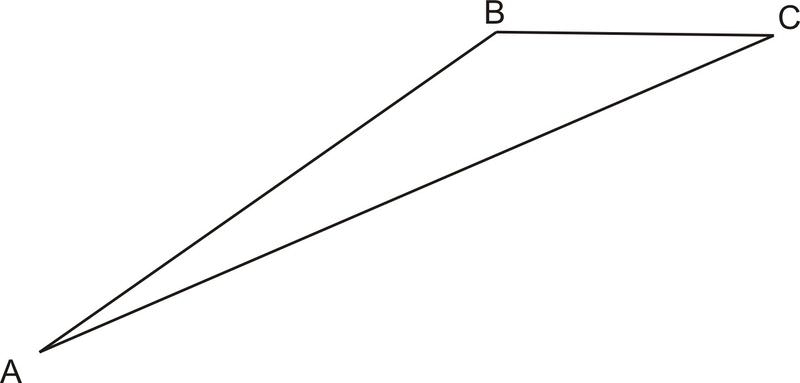
Solution
\(\dfrac{\sin 41.3^{\circ} }{214.9}=\dfrac{\sin 39.7^{\circ} }{d}\), \(d=208.0\)
Find side "o" in the triangle below with the following information: \(M=31^{\circ} \), \(O=9^{\circ} \), \(m=15\)

Solution
\(\dfrac{\sin 9^{\circ} }{o}=\dfrac{\sin 31^{\circ} }{15}\), \(o=4.6\)
Find side "q" in the triangle below with the following information: \(Q=127^{\circ} \), \(R=21.8^{\circ} \),\(r=3.62\)
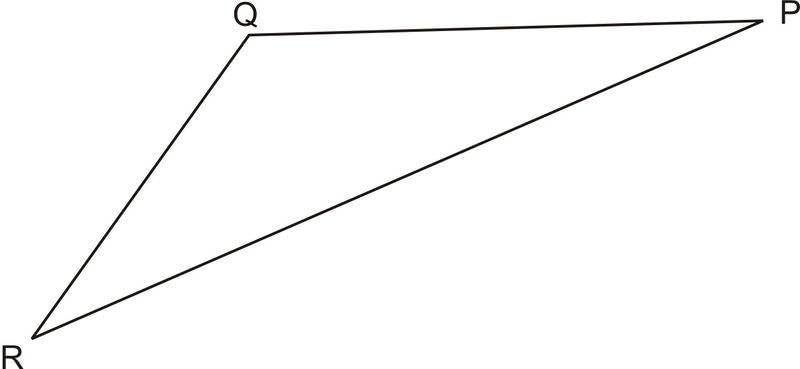
Solution
\(\dfrac{\sin 127^{\circ} }{q}=\dfrac{\sin 21.8^{\circ} }{3.62}\), \(q=7.8\)
Review
In \(\Delta ABC\), \(m\angle A=50^{\circ}\), \(m\angle B=34^{\circ}\), and \(a=6\).
- Find the length of \(b\).
- Find the length of \(c\).
In \(\Delta KMS\), \(m\angle K=42^{\circ}\), \(m\angle M=26^{\circ}\), and \(k=14\).
- Find the length of \(m\).
- Find the length of \(s\).
In \(\Delta DEF\), \(m\angle D=52^{\circ}\), \(m\angle E=78^{\circ}\), and \(d=23\).
- Find the length of \(e\).
- Find the length of \(f\).
In \(\Delta PQR\), \(m\angle P=2^{\circ}\), \(m\angle Q=79^{\circ}\), and \(p=20\).
- Find the length of \(q\).
- Find the length of \(r\).
In \(\Delta DOG\), \(m\angle D=50^{\circ} \), \(m\angle G=59^{\circ} \), and \(o=12\).
- Find the length of \(d\).
- Find the length of \(g\).
In \(\Delta CAT\), \(m\angle C=82^{\circ}\), \(m\angle T=4^{\circ}\), and a=8\).
- Find the length of c\).
- Find the length of t\).
In \(\Delta YOS\), \(m\angle Y=65^{\circ}\), \(m\angle O=72^{\circ}\), and \(s=15\).
- Find the length of \(o\).
- Find the length of \(y\).
In \(\Delta HCO\), \(m\angle H=87^{\circ}\), \(m\angle C=14^{\circ}\), and \(o=19\).
- Find the length of \(h\).
- Find the length of \(c\).
Review (Answers)
To see the Review answers, open this PDF file and look for section 5.7.
Vocabulary
| Term | Definition |
|---|---|
| Angle Angle Side Triangle | An 'angle angle side triangle' is a triangle where two of the angles and the non-included side are known quantities. |
Additional Resources
Video: Example: Solving a Triangle using the Law of sines Given Two Angles and One Side
Practice: Angle-Angle-Side Triangles

